Research Project: Massive MIMO Channel Model Research and Simulation
VerifiedAdded on 2023/05/31
|18
|4733
|492
Project
AI Summary
This project delves into the realm of Massive MIMO channel model research and simulation, providing a comprehensive overview of wireless communication systems. The document begins by outlining the motivation and background of Massive MIMO, highlighting the challenges in wireless communication and the evolution of MIMO technology. It explores the significance of channel models and simulations in evaluating system performance and understanding electromagnetic radiation effects. The research covers the development and trends in modern wireless communication, discussing the evolution of mobile technologies and the purpose of channel modeling and simulation. The project also emphasizes the importance of understanding critical theories, technologies, and research strategies. The document also explains the expected results and the critical theories related to the subject. The research includes an overview of the channel model, simulation, and data analysis, and discusses the different parameters that influence transmission processes. This work provides valuable insights into the advancements and complexities associated with Massive MIMO technology.

MASSIVE MIMO CHANNEL MODEL RESEARCH AND SIMULATION
MASSIVE MIMO CHANNEL MODEL RESEARCH AND SIMULATION
Name of the Student
Name of the University
Author Note
MASSIVE MIMO CHANNEL MODEL RESEARCH AND SIMULATION
Name of the Student
Name of the University
Author Note
Paraphrase This Document
Need a fresh take? Get an instant paraphrase of this document with our AI Paraphraser
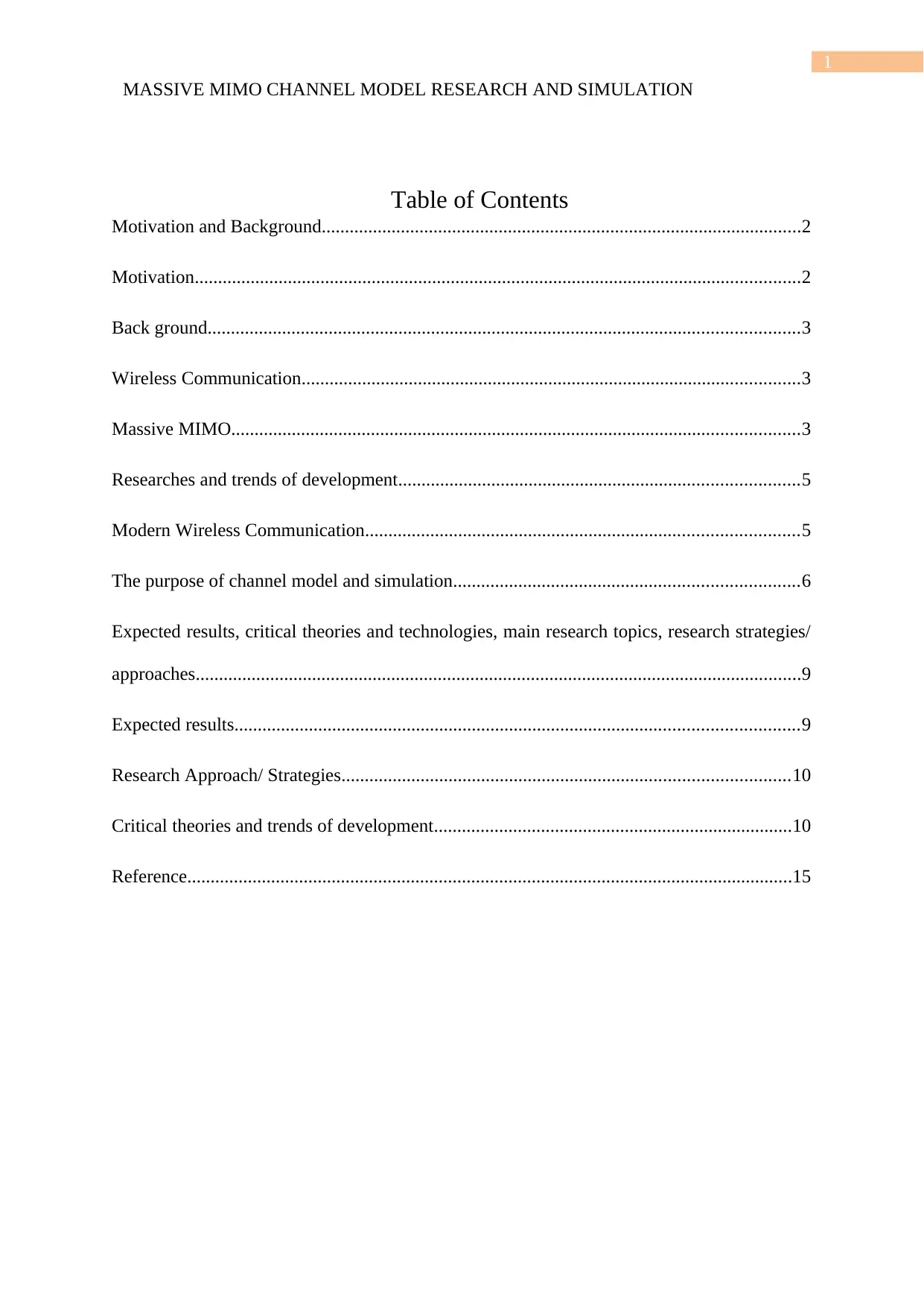
1
MASSIVE MIMO CHANNEL MODEL RESEARCH AND SIMULATION
Table of Contents
Motivation and Background.......................................................................................................2
Motivation..................................................................................................................................2
Back ground...............................................................................................................................3
Wireless Communication...........................................................................................................3
Massive MIMO..........................................................................................................................3
Researches and trends of development......................................................................................5
Modern Wireless Communication.............................................................................................5
The purpose of channel model and simulation..........................................................................6
Expected results, critical theories and technologies, main research topics, research strategies/
approaches..................................................................................................................................9
Expected results.........................................................................................................................9
Research Approach/ Strategies................................................................................................10
Critical theories and trends of development.............................................................................10
Reference..................................................................................................................................15
MASSIVE MIMO CHANNEL MODEL RESEARCH AND SIMULATION
Table of Contents
Motivation and Background.......................................................................................................2
Motivation..................................................................................................................................2
Back ground...............................................................................................................................3
Wireless Communication...........................................................................................................3
Massive MIMO..........................................................................................................................3
Researches and trends of development......................................................................................5
Modern Wireless Communication.............................................................................................5
The purpose of channel model and simulation..........................................................................6
Expected results, critical theories and technologies, main research topics, research strategies/
approaches..................................................................................................................................9
Expected results.........................................................................................................................9
Research Approach/ Strategies................................................................................................10
Critical theories and trends of development.............................................................................10
Reference..................................................................................................................................15
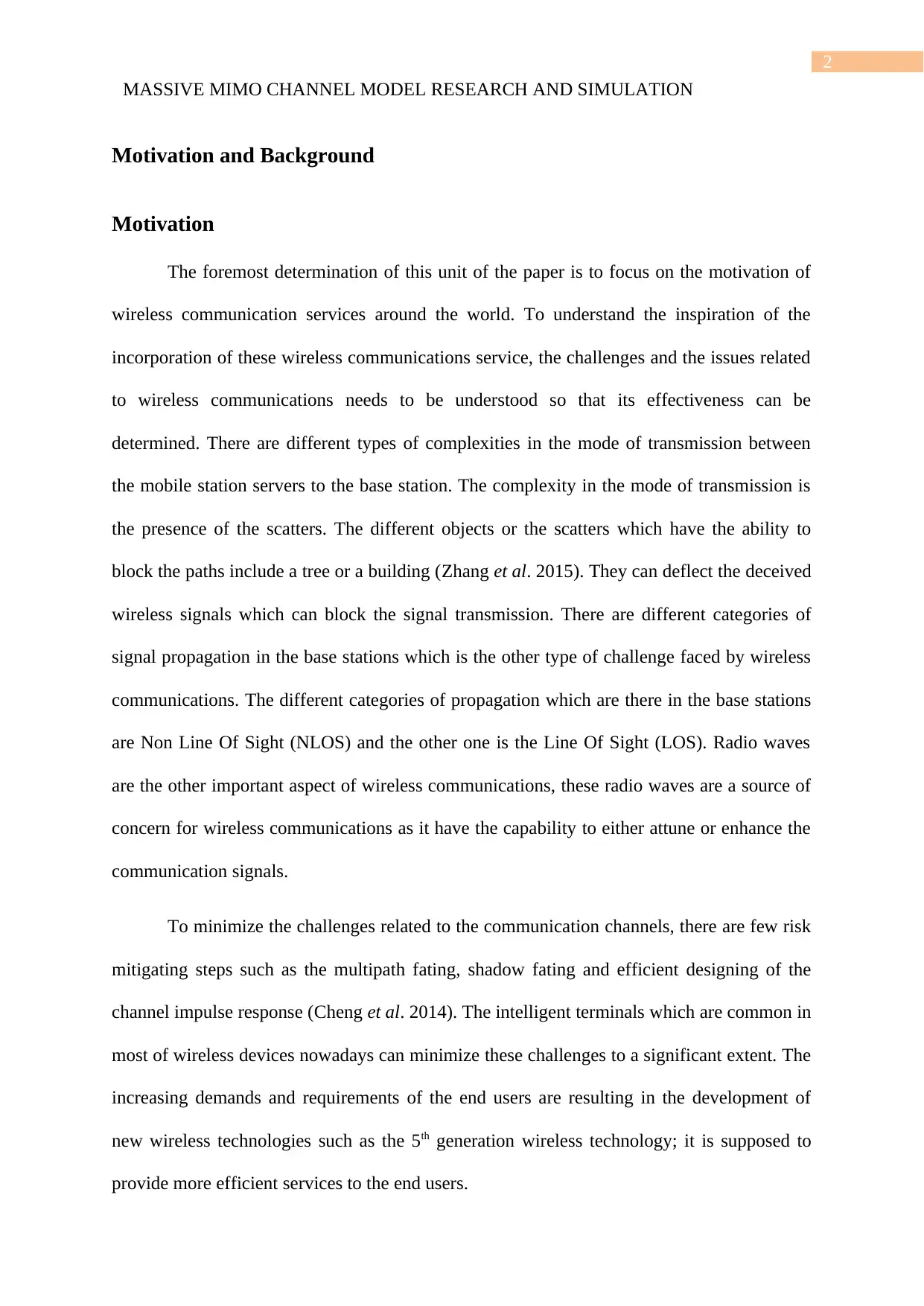
2
MASSIVE MIMO CHANNEL MODEL RESEARCH AND SIMULATION
Motivation and Background
Motivation
The foremost determination of this unit of the paper is to focus on the motivation of
wireless communication services around the world. To understand the inspiration of the
incorporation of these wireless communications service, the challenges and the issues related
to wireless communications needs to be understood so that its effectiveness can be
determined. There are different types of complexities in the mode of transmission between
the mobile station servers to the base station. The complexity in the mode of transmission is
the presence of the scatters. The different objects or the scatters which have the ability to
block the paths include a tree or a building (Zhang et al. 2015). They can deflect the deceived
wireless signals which can block the signal transmission. There are different categories of
signal propagation in the base stations which is the other type of challenge faced by wireless
communications. The different categories of propagation which are there in the base stations
are Non Line Of Sight (NLOS) and the other one is the Line Of Sight (LOS). Radio waves
are the other important aspect of wireless communications, these radio waves are a source of
concern for wireless communications as it have the capability to either attune or enhance the
communication signals.
To minimize the challenges related to the communication channels, there are few risk
mitigating steps such as the multipath fating, shadow fating and efficient designing of the
channel impulse response (Cheng et al. 2014). The intelligent terminals which are common in
most of wireless devices nowadays can minimize these challenges to a significant extent. The
increasing demands and requirements of the end users are resulting in the development of
new wireless technologies such as the 5th generation wireless technology; it is supposed to
provide more efficient services to the end users.
MASSIVE MIMO CHANNEL MODEL RESEARCH AND SIMULATION
Motivation and Background
Motivation
The foremost determination of this unit of the paper is to focus on the motivation of
wireless communication services around the world. To understand the inspiration of the
incorporation of these wireless communications service, the challenges and the issues related
to wireless communications needs to be understood so that its effectiveness can be
determined. There are different types of complexities in the mode of transmission between
the mobile station servers to the base station. The complexity in the mode of transmission is
the presence of the scatters. The different objects or the scatters which have the ability to
block the paths include a tree or a building (Zhang et al. 2015). They can deflect the deceived
wireless signals which can block the signal transmission. There are different categories of
signal propagation in the base stations which is the other type of challenge faced by wireless
communications. The different categories of propagation which are there in the base stations
are Non Line Of Sight (NLOS) and the other one is the Line Of Sight (LOS). Radio waves
are the other important aspect of wireless communications, these radio waves are a source of
concern for wireless communications as it have the capability to either attune or enhance the
communication signals.
To minimize the challenges related to the communication channels, there are few risk
mitigating steps such as the multipath fating, shadow fating and efficient designing of the
channel impulse response (Cheng et al. 2014). The intelligent terminals which are common in
most of wireless devices nowadays can minimize these challenges to a significant extent. The
increasing demands and requirements of the end users are resulting in the development of
new wireless technologies such as the 5th generation wireless technology; it is supposed to
provide more efficient services to the end users.
⊘ This is a preview!⊘
Do you want full access?
Subscribe today to unlock all pages.

Trusted by 1+ million students worldwide
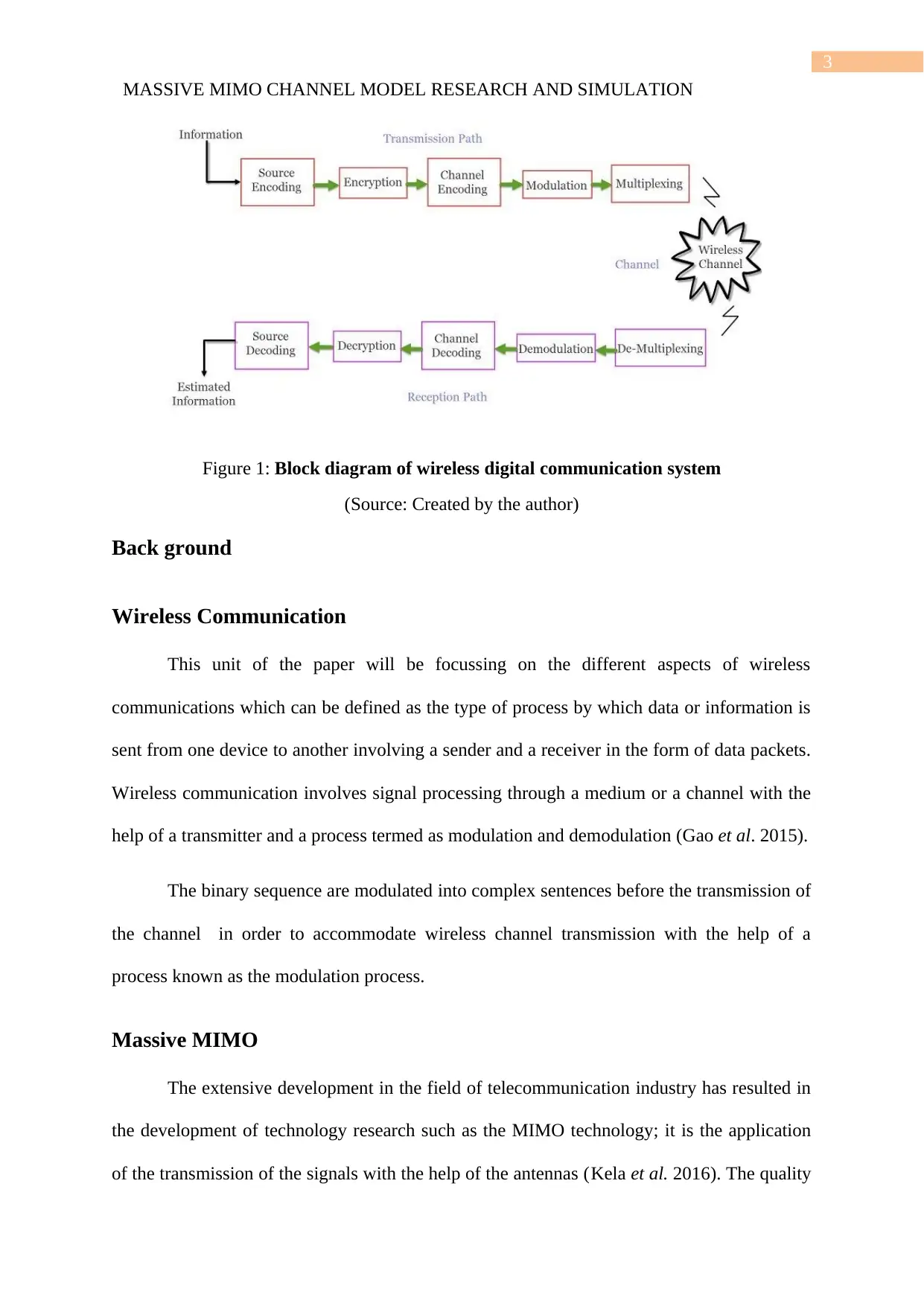
3
MASSIVE MIMO CHANNEL MODEL RESEARCH AND SIMULATION
Figure 1: Block diagram of wireless digital communication system
(Source: Created by the author)
Back ground
Wireless Communication
This unit of the paper will be focussing on the different aspects of wireless
communications which can be defined as the type of process by which data or information is
sent from one device to another involving a sender and a receiver in the form of data packets.
Wireless communication involves signal processing through a medium or a channel with the
help of a transmitter and a process termed as modulation and demodulation (Gao et al. 2015).
The binary sequence are modulated into complex sentences before the transmission of
the channel in order to accommodate wireless channel transmission with the help of a
process known as the modulation process.
Massive MIMO
The extensive development in the field of telecommunication industry has resulted in
the development of technology research such as the MIMO technology; it is the application
of the transmission of the signals with the help of the antennas (Kela et al. 2016). The quality
MASSIVE MIMO CHANNEL MODEL RESEARCH AND SIMULATION
Figure 1: Block diagram of wireless digital communication system
(Source: Created by the author)
Back ground
Wireless Communication
This unit of the paper will be focussing on the different aspects of wireless
communications which can be defined as the type of process by which data or information is
sent from one device to another involving a sender and a receiver in the form of data packets.
Wireless communication involves signal processing through a medium or a channel with the
help of a transmitter and a process termed as modulation and demodulation (Gao et al. 2015).
The binary sequence are modulated into complex sentences before the transmission of
the channel in order to accommodate wireless channel transmission with the help of a
process known as the modulation process.
Massive MIMO
The extensive development in the field of telecommunication industry has resulted in
the development of technology research such as the MIMO technology; it is the application
of the transmission of the signals with the help of the antennas (Kela et al. 2016). The quality
Paraphrase This Document
Need a fresh take? Get an instant paraphrase of this document with our AI Paraphraser
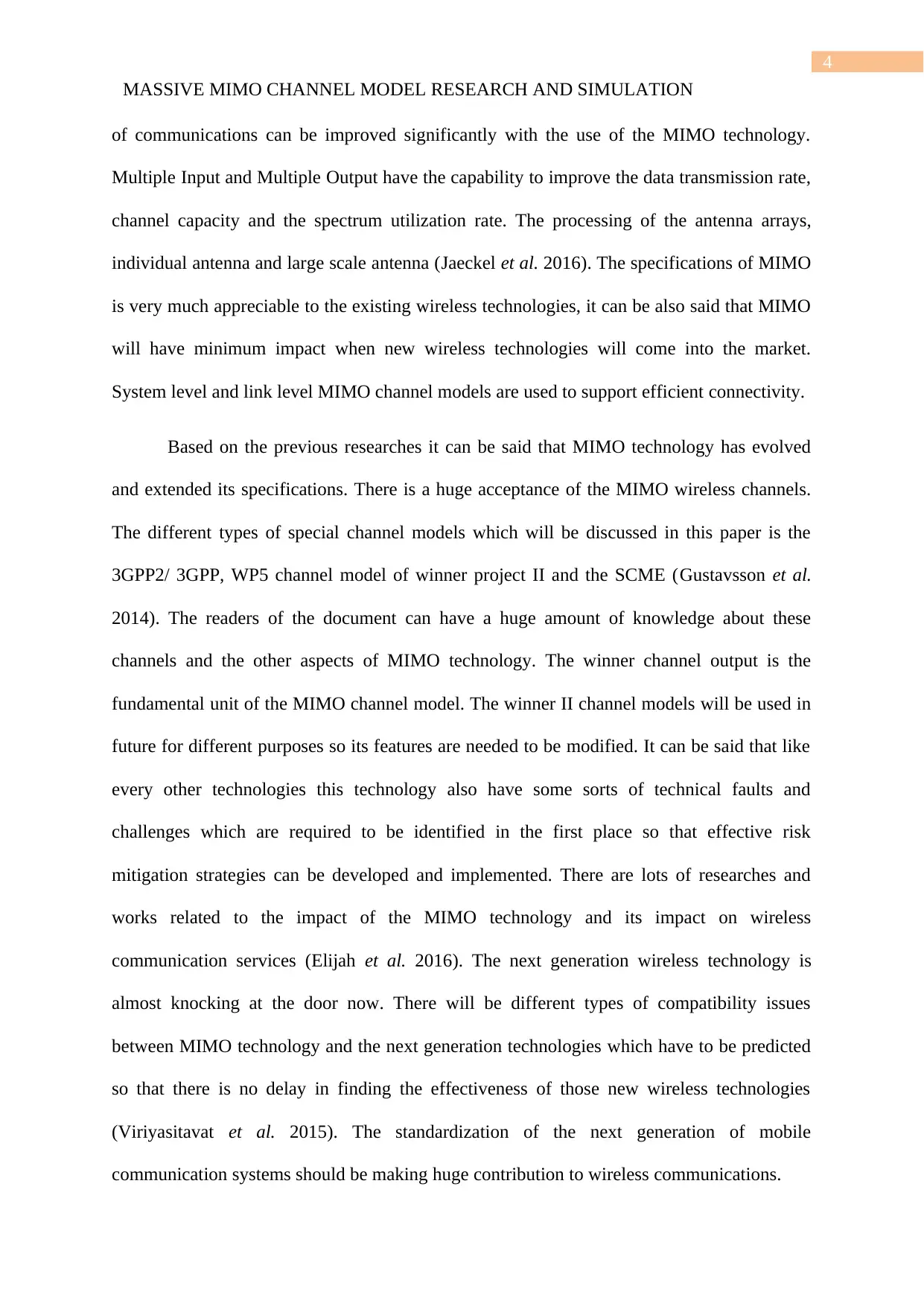
4
MASSIVE MIMO CHANNEL MODEL RESEARCH AND SIMULATION
of communications can be improved significantly with the use of the MIMO technology.
Multiple Input and Multiple Output have the capability to improve the data transmission rate,
channel capacity and the spectrum utilization rate. The processing of the antenna arrays,
individual antenna and large scale antenna (Jaeckel et al. 2016). The specifications of MIMO
is very much appreciable to the existing wireless technologies, it can be also said that MIMO
will have minimum impact when new wireless technologies will come into the market.
System level and link level MIMO channel models are used to support efficient connectivity.
Based on the previous researches it can be said that MIMO technology has evolved
and extended its specifications. There is a huge acceptance of the MIMO wireless channels.
The different types of special channel models which will be discussed in this paper is the
3GPP2/ 3GPP, WP5 channel model of winner project II and the SCME (Gustavsson et al.
2014). The readers of the document can have a huge amount of knowledge about these
channels and the other aspects of MIMO technology. The winner channel output is the
fundamental unit of the MIMO channel model. The winner II channel models will be used in
future for different purposes so its features are needed to be modified. It can be said that like
every other technologies this technology also have some sorts of technical faults and
challenges which are required to be identified in the first place so that effective risk
mitigation strategies can be developed and implemented. There are lots of researches and
works related to the impact of the MIMO technology and its impact on wireless
communication services (Elijah et al. 2016). The next generation wireless technology is
almost knocking at the door now. There will be different types of compatibility issues
between MIMO technology and the next generation technologies which have to be predicted
so that there is no delay in finding the effectiveness of those new wireless technologies
(Viriyasitavat et al. 2015). The standardization of the next generation of mobile
communication systems should be making huge contribution to wireless communications.
MASSIVE MIMO CHANNEL MODEL RESEARCH AND SIMULATION
of communications can be improved significantly with the use of the MIMO technology.
Multiple Input and Multiple Output have the capability to improve the data transmission rate,
channel capacity and the spectrum utilization rate. The processing of the antenna arrays,
individual antenna and large scale antenna (Jaeckel et al. 2016). The specifications of MIMO
is very much appreciable to the existing wireless technologies, it can be also said that MIMO
will have minimum impact when new wireless technologies will come into the market.
System level and link level MIMO channel models are used to support efficient connectivity.
Based on the previous researches it can be said that MIMO technology has evolved
and extended its specifications. There is a huge acceptance of the MIMO wireless channels.
The different types of special channel models which will be discussed in this paper is the
3GPP2/ 3GPP, WP5 channel model of winner project II and the SCME (Gustavsson et al.
2014). The readers of the document can have a huge amount of knowledge about these
channels and the other aspects of MIMO technology. The winner channel output is the
fundamental unit of the MIMO channel model. The winner II channel models will be used in
future for different purposes so its features are needed to be modified. It can be said that like
every other technologies this technology also have some sorts of technical faults and
challenges which are required to be identified in the first place so that effective risk
mitigation strategies can be developed and implemented. There are lots of researches and
works related to the impact of the MIMO technology and its impact on wireless
communication services (Elijah et al. 2016). The next generation wireless technology is
almost knocking at the door now. There will be different types of compatibility issues
between MIMO technology and the next generation technologies which have to be predicted
so that there is no delay in finding the effectiveness of those new wireless technologies
(Viriyasitavat et al. 2015). The standardization of the next generation of mobile
communication systems should be making huge contribution to wireless communications.
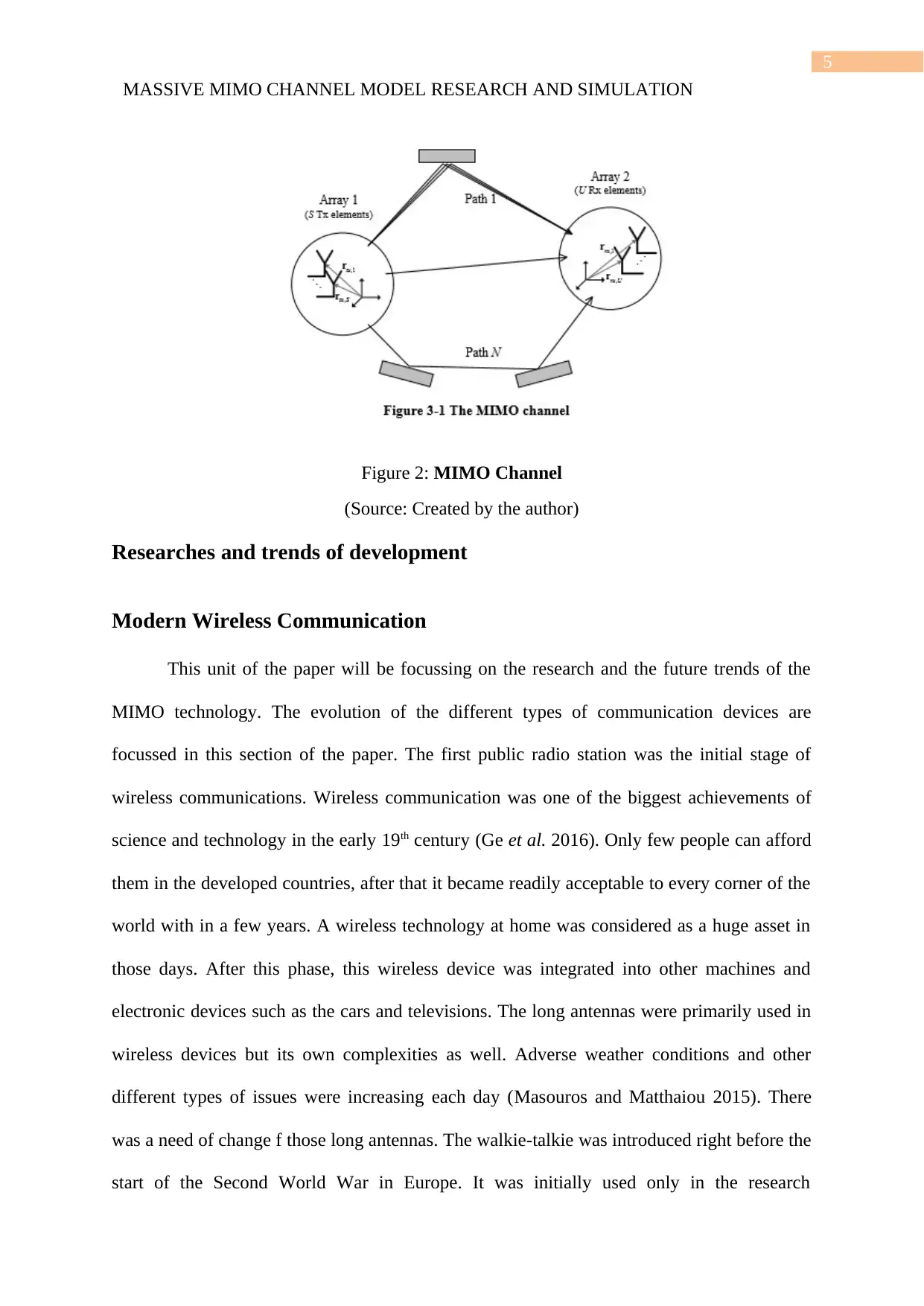
5
MASSIVE MIMO CHANNEL MODEL RESEARCH AND SIMULATION
Figure 2: MIMO Channel
(Source: Created by the author)
Researches and trends of development
Modern Wireless Communication
This unit of the paper will be focussing on the research and the future trends of the
MIMO technology. The evolution of the different types of communication devices are
focussed in this section of the paper. The first public radio station was the initial stage of
wireless communications. Wireless communication was one of the biggest achievements of
science and technology in the early 19th century (Ge et al. 2016). Only few people can afford
them in the developed countries, after that it became readily acceptable to every corner of the
world with in a few years. A wireless technology at home was considered as a huge asset in
those days. After this phase, this wireless device was integrated into other machines and
electronic devices such as the cars and televisions. The long antennas were primarily used in
wireless devices but its own complexities as well. Adverse weather conditions and other
different types of issues were increasing each day (Masouros and Matthaiou 2015). There
was a need of change f those long antennas. The walkie-talkie was introduced right before the
start of the Second World War in Europe. It was initially used only in the research
MASSIVE MIMO CHANNEL MODEL RESEARCH AND SIMULATION
Figure 2: MIMO Channel
(Source: Created by the author)
Researches and trends of development
Modern Wireless Communication
This unit of the paper will be focussing on the research and the future trends of the
MIMO technology. The evolution of the different types of communication devices are
focussed in this section of the paper. The first public radio station was the initial stage of
wireless communications. Wireless communication was one of the biggest achievements of
science and technology in the early 19th century (Ge et al. 2016). Only few people can afford
them in the developed countries, after that it became readily acceptable to every corner of the
world with in a few years. A wireless technology at home was considered as a huge asset in
those days. After this phase, this wireless device was integrated into other machines and
electronic devices such as the cars and televisions. The long antennas were primarily used in
wireless devices but its own complexities as well. Adverse weather conditions and other
different types of issues were increasing each day (Masouros and Matthaiou 2015). There
was a need of change f those long antennas. The walkie-talkie was introduced right before the
start of the Second World War in Europe. It was initially used only in the research
⊘ This is a preview!⊘
Do you want full access?
Subscribe today to unlock all pages.

Trusted by 1+ million students worldwide
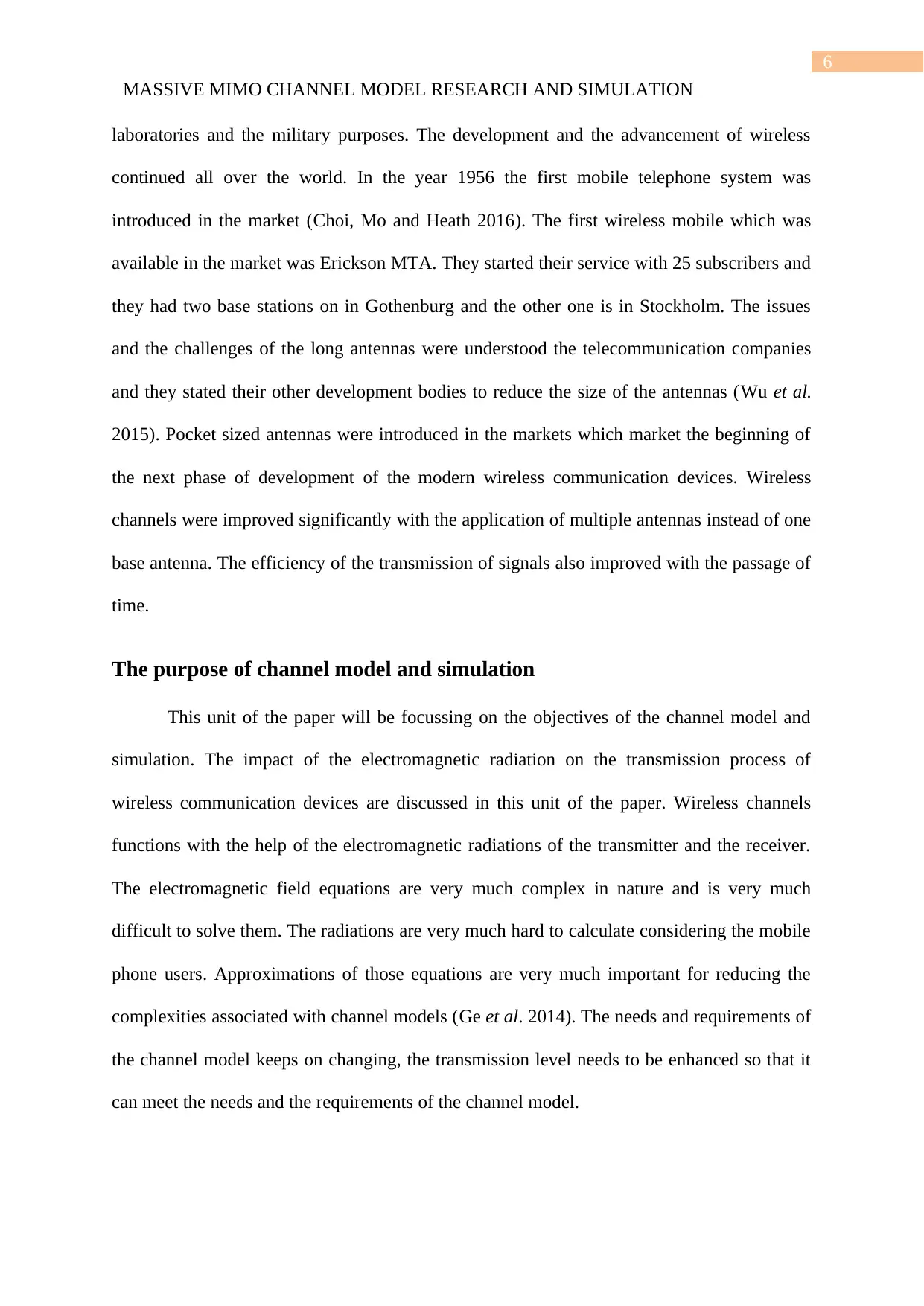
6
MASSIVE MIMO CHANNEL MODEL RESEARCH AND SIMULATION
laboratories and the military purposes. The development and the advancement of wireless
continued all over the world. In the year 1956 the first mobile telephone system was
introduced in the market (Choi, Mo and Heath 2016). The first wireless mobile which was
available in the market was Erickson MTA. They started their service with 25 subscribers and
they had two base stations on in Gothenburg and the other one is in Stockholm. The issues
and the challenges of the long antennas were understood the telecommunication companies
and they stated their other development bodies to reduce the size of the antennas (Wu et al.
2015). Pocket sized antennas were introduced in the markets which market the beginning of
the next phase of development of the modern wireless communication devices. Wireless
channels were improved significantly with the application of multiple antennas instead of one
base antenna. The efficiency of the transmission of signals also improved with the passage of
time.
The purpose of channel model and simulation
This unit of the paper will be focussing on the objectives of the channel model and
simulation. The impact of the electromagnetic radiation on the transmission process of
wireless communication devices are discussed in this unit of the paper. Wireless channels
functions with the help of the electromagnetic radiations of the transmitter and the receiver.
The electromagnetic field equations are very much complex in nature and is very much
difficult to solve them. The radiations are very much hard to calculate considering the mobile
phone users. Approximations of those equations are very much important for reducing the
complexities associated with channel models (Ge et al. 2014). The needs and requirements of
the channel model keeps on changing, the transmission level needs to be enhanced so that it
can meet the needs and the requirements of the channel model.
MASSIVE MIMO CHANNEL MODEL RESEARCH AND SIMULATION
laboratories and the military purposes. The development and the advancement of wireless
continued all over the world. In the year 1956 the first mobile telephone system was
introduced in the market (Choi, Mo and Heath 2016). The first wireless mobile which was
available in the market was Erickson MTA. They started their service with 25 subscribers and
they had two base stations on in Gothenburg and the other one is in Stockholm. The issues
and the challenges of the long antennas were understood the telecommunication companies
and they stated their other development bodies to reduce the size of the antennas (Wu et al.
2015). Pocket sized antennas were introduced in the markets which market the beginning of
the next phase of development of the modern wireless communication devices. Wireless
channels were improved significantly with the application of multiple antennas instead of one
base antenna. The efficiency of the transmission of signals also improved with the passage of
time.
The purpose of channel model and simulation
This unit of the paper will be focussing on the objectives of the channel model and
simulation. The impact of the electromagnetic radiation on the transmission process of
wireless communication devices are discussed in this unit of the paper. Wireless channels
functions with the help of the electromagnetic radiations of the transmitter and the receiver.
The electromagnetic field equations are very much complex in nature and is very much
difficult to solve them. The radiations are very much hard to calculate considering the mobile
phone users. Approximations of those equations are very much important for reducing the
complexities associated with channel models (Ge et al. 2014). The needs and requirements of
the channel model keeps on changing, the transmission level needs to be enhanced so that it
can meet the needs and the requirements of the channel model.
Paraphrase This Document
Need a fresh take? Get an instant paraphrase of this document with our AI Paraphraser
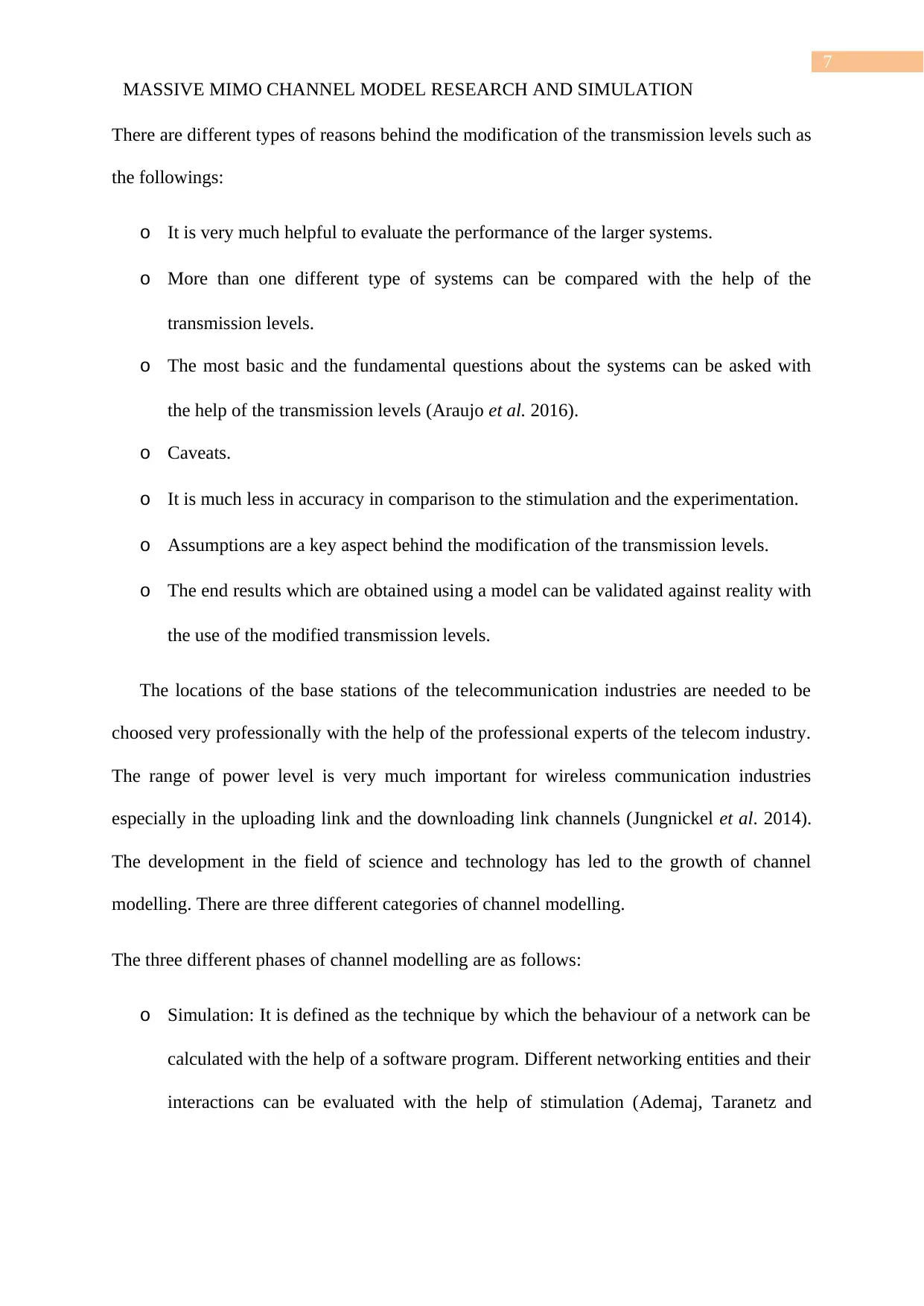
7
MASSIVE MIMO CHANNEL MODEL RESEARCH AND SIMULATION
There are different types of reasons behind the modification of the transmission levels such as
the followings:
o It is very much helpful to evaluate the performance of the larger systems.
o More than one different type of systems can be compared with the help of the
transmission levels.
o The most basic and the fundamental questions about the systems can be asked with
the help of the transmission levels (Araujo et al. 2016).
o Caveats.
o It is much less in accuracy in comparison to the stimulation and the experimentation.
o Assumptions are a key aspect behind the modification of the transmission levels.
o The end results which are obtained using a model can be validated against reality with
the use of the modified transmission levels.
The locations of the base stations of the telecommunication industries are needed to be
choosed very professionally with the help of the professional experts of the telecom industry.
The range of power level is very much important for wireless communication industries
especially in the uploading link and the downloading link channels (Jungnickel et al. 2014).
The development in the field of science and technology has led to the growth of channel
modelling. There are three different categories of channel modelling.
The three different phases of channel modelling are as follows:
o Simulation: It is defined as the technique by which the behaviour of a network can be
calculated with the help of a software program. Different networking entities and their
interactions can be evaluated with the help of stimulation (Ademaj, Taranetz and
MASSIVE MIMO CHANNEL MODEL RESEARCH AND SIMULATION
There are different types of reasons behind the modification of the transmission levels such as
the followings:
o It is very much helpful to evaluate the performance of the larger systems.
o More than one different type of systems can be compared with the help of the
transmission levels.
o The most basic and the fundamental questions about the systems can be asked with
the help of the transmission levels (Araujo et al. 2016).
o Caveats.
o It is much less in accuracy in comparison to the stimulation and the experimentation.
o Assumptions are a key aspect behind the modification of the transmission levels.
o The end results which are obtained using a model can be validated against reality with
the use of the modified transmission levels.
The locations of the base stations of the telecommunication industries are needed to be
choosed very professionally with the help of the professional experts of the telecom industry.
The range of power level is very much important for wireless communication industries
especially in the uploading link and the downloading link channels (Jungnickel et al. 2014).
The development in the field of science and technology has led to the growth of channel
modelling. There are three different categories of channel modelling.
The three different phases of channel modelling are as follows:
o Simulation: It is defined as the technique by which the behaviour of a network can be
calculated with the help of a software program. Different networking entities and their
interactions can be evaluated with the help of stimulation (Ademaj, Taranetz and
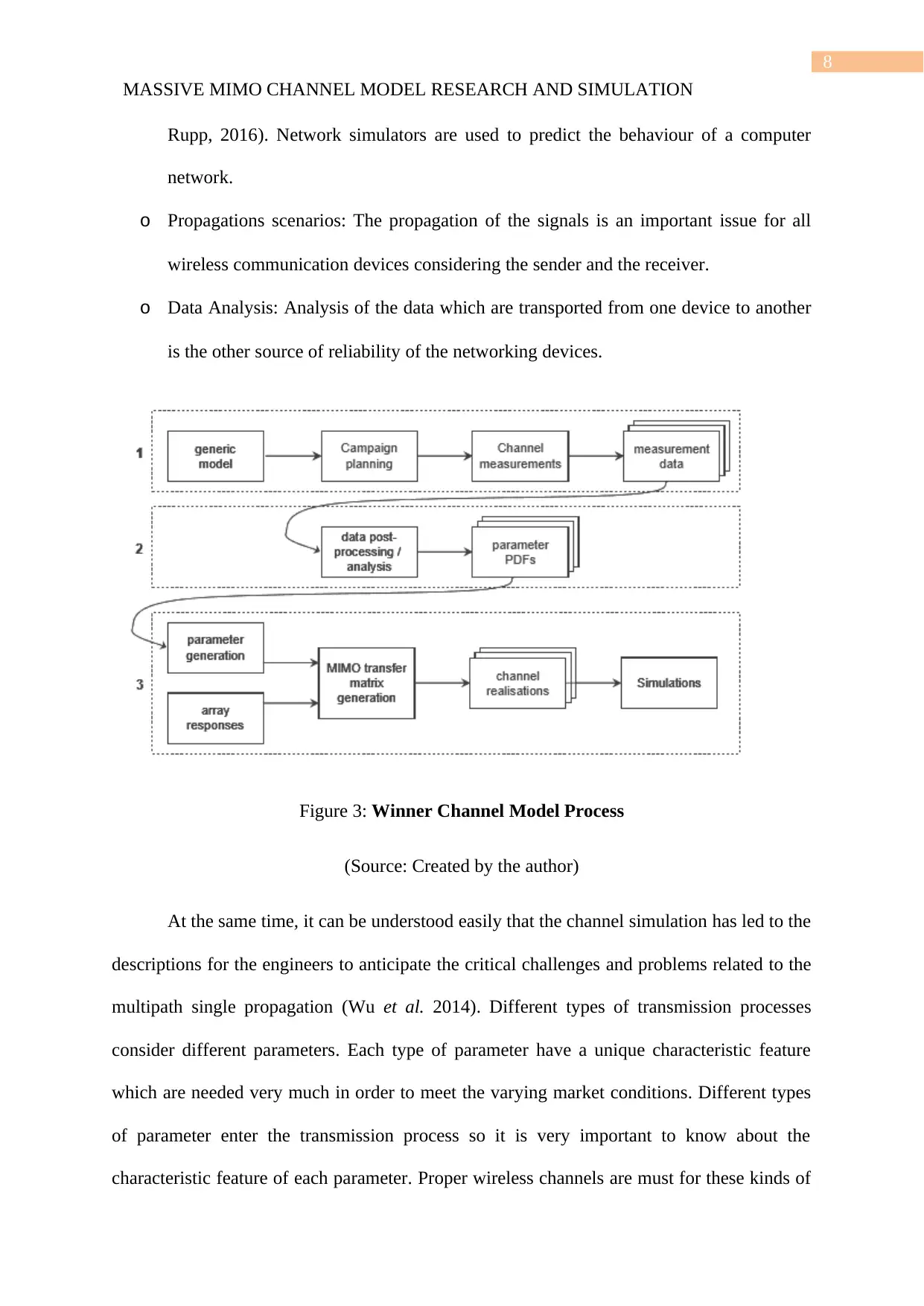
8
MASSIVE MIMO CHANNEL MODEL RESEARCH AND SIMULATION
Rupp, 2016). Network simulators are used to predict the behaviour of a computer
network.
o Propagations scenarios: The propagation of the signals is an important issue for all
wireless communication devices considering the sender and the receiver.
o Data Analysis: Analysis of the data which are transported from one device to another
is the other source of reliability of the networking devices.
Figure 3: Winner Channel Model Process
(Source: Created by the author)
At the same time, it can be understood easily that the channel simulation has led to the
descriptions for the engineers to anticipate the critical challenges and problems related to the
multipath single propagation (Wu et al. 2014). Different types of transmission processes
consider different parameters. Each type of parameter have a unique characteristic feature
which are needed very much in order to meet the varying market conditions. Different types
of parameter enter the transmission process so it is very important to know about the
characteristic feature of each parameter. Proper wireless channels are must for these kinds of
MASSIVE MIMO CHANNEL MODEL RESEARCH AND SIMULATION
Rupp, 2016). Network simulators are used to predict the behaviour of a computer
network.
o Propagations scenarios: The propagation of the signals is an important issue for all
wireless communication devices considering the sender and the receiver.
o Data Analysis: Analysis of the data which are transported from one device to another
is the other source of reliability of the networking devices.
Figure 3: Winner Channel Model Process
(Source: Created by the author)
At the same time, it can be understood easily that the channel simulation has led to the
descriptions for the engineers to anticipate the critical challenges and problems related to the
multipath single propagation (Wu et al. 2014). Different types of transmission processes
consider different parameters. Each type of parameter have a unique characteristic feature
which are needed very much in order to meet the varying market conditions. Different types
of parameter enter the transmission process so it is very important to know about the
characteristic feature of each parameter. Proper wireless channels are must for these kinds of
⊘ This is a preview!⊘
Do you want full access?
Subscribe today to unlock all pages.

Trusted by 1+ million students worldwide
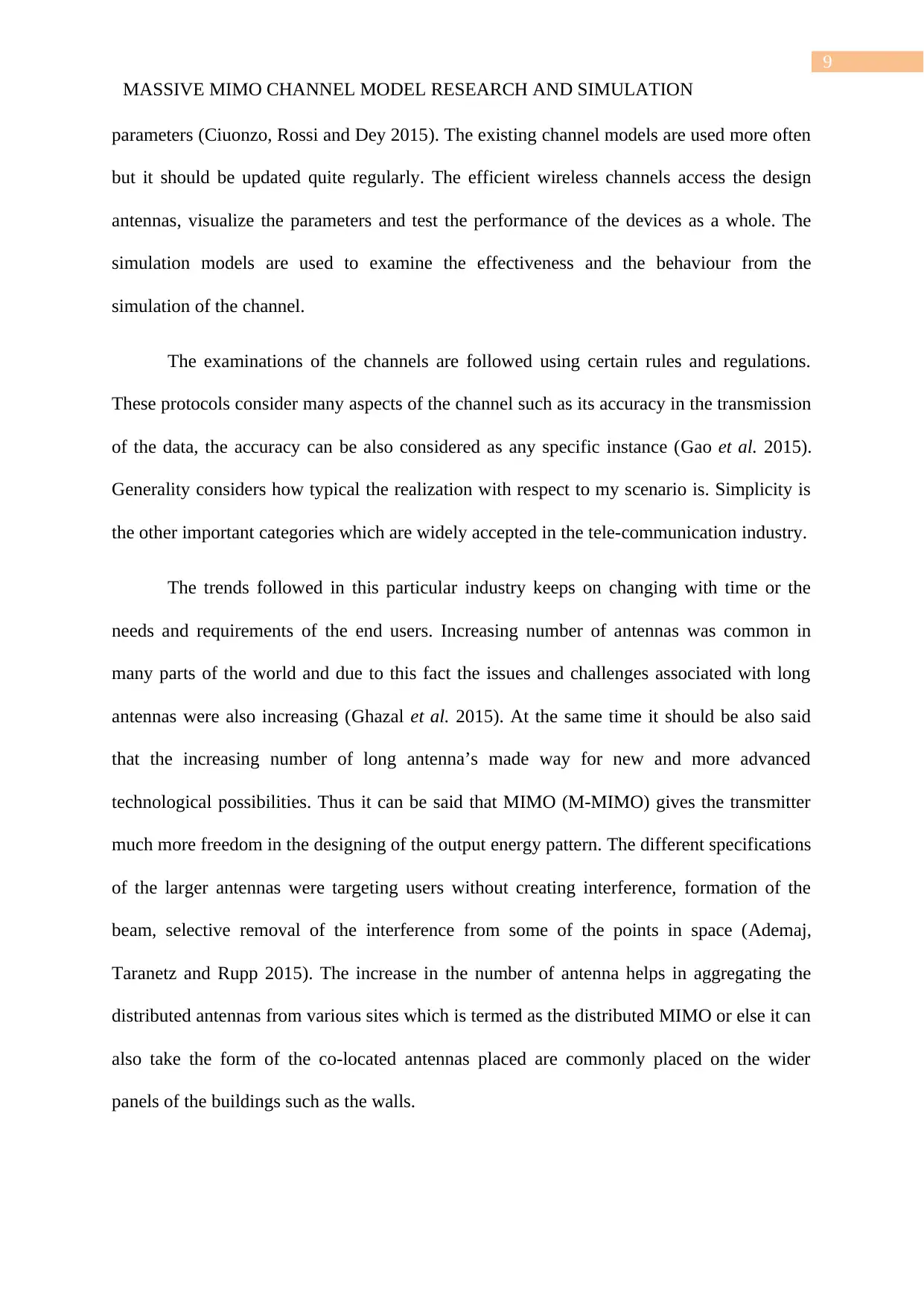
9
MASSIVE MIMO CHANNEL MODEL RESEARCH AND SIMULATION
parameters (Ciuonzo, Rossi and Dey 2015). The existing channel models are used more often
but it should be updated quite regularly. The efficient wireless channels access the design
antennas, visualize the parameters and test the performance of the devices as a whole. The
simulation models are used to examine the effectiveness and the behaviour from the
simulation of the channel.
The examinations of the channels are followed using certain rules and regulations.
These protocols consider many aspects of the channel such as its accuracy in the transmission
of the data, the accuracy can be also considered as any specific instance (Gao et al. 2015).
Generality considers how typical the realization with respect to my scenario is. Simplicity is
the other important categories which are widely accepted in the tele-communication industry.
The trends followed in this particular industry keeps on changing with time or the
needs and requirements of the end users. Increasing number of antennas was common in
many parts of the world and due to this fact the issues and challenges associated with long
antennas were also increasing (Ghazal et al. 2015). At the same time it should be also said
that the increasing number of long antenna’s made way for new and more advanced
technological possibilities. Thus it can be said that MIMO (M-MIMO) gives the transmitter
much more freedom in the designing of the output energy pattern. The different specifications
of the larger antennas were targeting users without creating interference, formation of the
beam, selective removal of the interference from some of the points in space (Ademaj,
Taranetz and Rupp 2015). The increase in the number of antenna helps in aggregating the
distributed antennas from various sites which is termed as the distributed MIMO or else it can
also take the form of the co-located antennas placed are commonly placed on the wider
panels of the buildings such as the walls.
MASSIVE MIMO CHANNEL MODEL RESEARCH AND SIMULATION
parameters (Ciuonzo, Rossi and Dey 2015). The existing channel models are used more often
but it should be updated quite regularly. The efficient wireless channels access the design
antennas, visualize the parameters and test the performance of the devices as a whole. The
simulation models are used to examine the effectiveness and the behaviour from the
simulation of the channel.
The examinations of the channels are followed using certain rules and regulations.
These protocols consider many aspects of the channel such as its accuracy in the transmission
of the data, the accuracy can be also considered as any specific instance (Gao et al. 2015).
Generality considers how typical the realization with respect to my scenario is. Simplicity is
the other important categories which are widely accepted in the tele-communication industry.
The trends followed in this particular industry keeps on changing with time or the
needs and requirements of the end users. Increasing number of antennas was common in
many parts of the world and due to this fact the issues and challenges associated with long
antennas were also increasing (Ghazal et al. 2015). At the same time it should be also said
that the increasing number of long antenna’s made way for new and more advanced
technological possibilities. Thus it can be said that MIMO (M-MIMO) gives the transmitter
much more freedom in the designing of the output energy pattern. The different specifications
of the larger antennas were targeting users without creating interference, formation of the
beam, selective removal of the interference from some of the points in space (Ademaj,
Taranetz and Rupp 2015). The increase in the number of antenna helps in aggregating the
distributed antennas from various sites which is termed as the distributed MIMO or else it can
also take the form of the co-located antennas placed are commonly placed on the wider
panels of the buildings such as the walls.
Paraphrase This Document
Need a fresh take? Get an instant paraphrase of this document with our AI Paraphraser
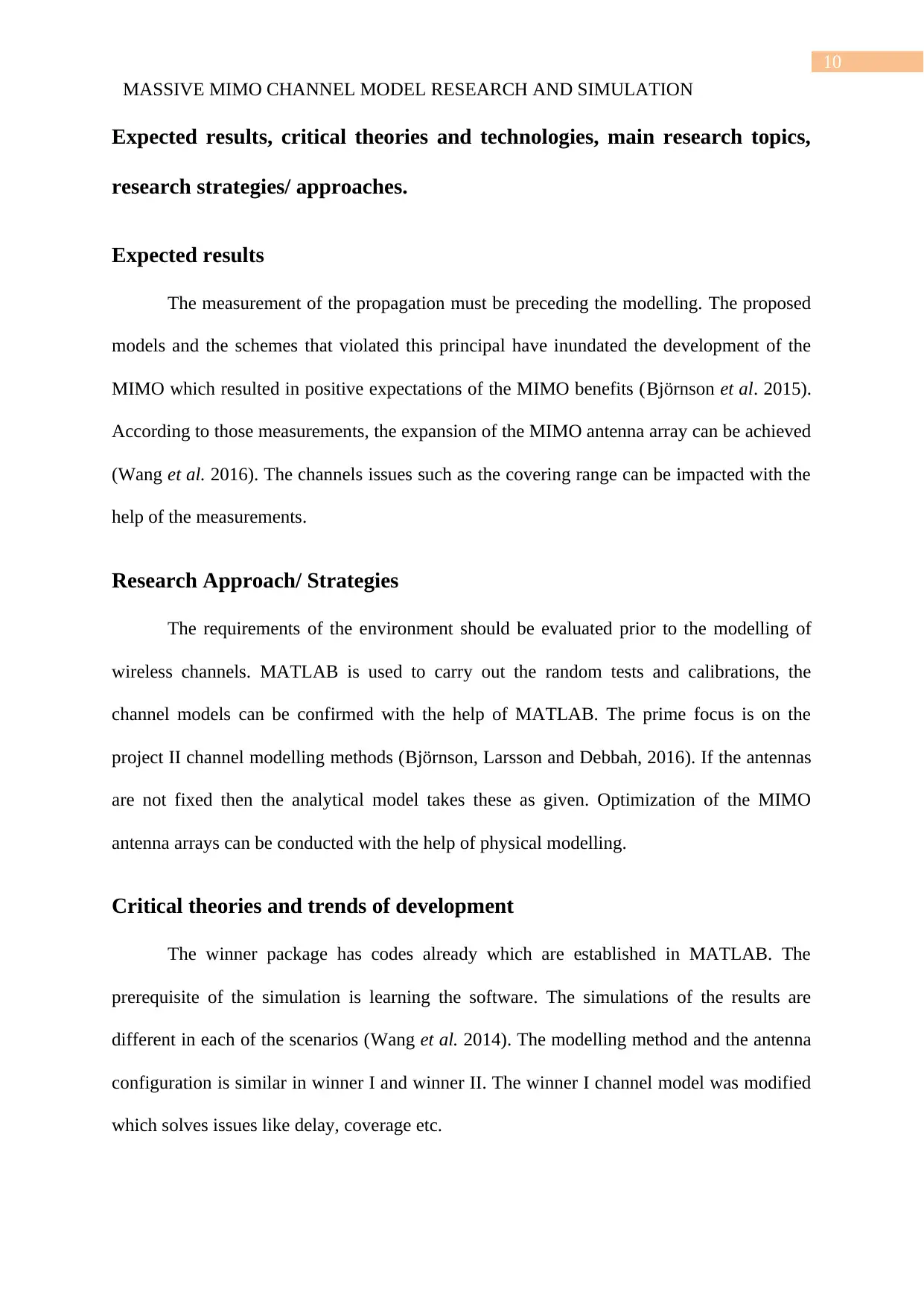
10
MASSIVE MIMO CHANNEL MODEL RESEARCH AND SIMULATION
Expected results, critical theories and technologies, main research topics,
research strategies/ approaches.
Expected results
The measurement of the propagation must be preceding the modelling. The proposed
models and the schemes that violated this principal have inundated the development of the
MIMO which resulted in positive expectations of the MIMO benefits (Björnson et al. 2015).
According to those measurements, the expansion of the MIMO antenna array can be achieved
(Wang et al. 2016). The channels issues such as the covering range can be impacted with the
help of the measurements.
Research Approach/ Strategies
The requirements of the environment should be evaluated prior to the modelling of
wireless channels. MATLAB is used to carry out the random tests and calibrations, the
channel models can be confirmed with the help of MATLAB. The prime focus is on the
project II channel modelling methods (Björnson, Larsson and Debbah, 2016). If the antennas
are not fixed then the analytical model takes these as given. Optimization of the MIMO
antenna arrays can be conducted with the help of physical modelling.
Critical theories and trends of development
The winner package has codes already which are established in MATLAB. The
prerequisite of the simulation is learning the software. The simulations of the results are
different in each of the scenarios (Wang et al. 2014). The modelling method and the antenna
configuration is similar in winner I and winner II. The winner I channel model was modified
which solves issues like delay, coverage etc.
MASSIVE MIMO CHANNEL MODEL RESEARCH AND SIMULATION
Expected results, critical theories and technologies, main research topics,
research strategies/ approaches.
Expected results
The measurement of the propagation must be preceding the modelling. The proposed
models and the schemes that violated this principal have inundated the development of the
MIMO which resulted in positive expectations of the MIMO benefits (Björnson et al. 2015).
According to those measurements, the expansion of the MIMO antenna array can be achieved
(Wang et al. 2016). The channels issues such as the covering range can be impacted with the
help of the measurements.
Research Approach/ Strategies
The requirements of the environment should be evaluated prior to the modelling of
wireless channels. MATLAB is used to carry out the random tests and calibrations, the
channel models can be confirmed with the help of MATLAB. The prime focus is on the
project II channel modelling methods (Björnson, Larsson and Debbah, 2016). If the antennas
are not fixed then the analytical model takes these as given. Optimization of the MIMO
antenna arrays can be conducted with the help of physical modelling.
Critical theories and trends of development
The winner package has codes already which are established in MATLAB. The
prerequisite of the simulation is learning the software. The simulations of the results are
different in each of the scenarios (Wang et al. 2014). The modelling method and the antenna
configuration is similar in winner I and winner II. The winner I channel model was modified
which solves issues like delay, coverage etc.
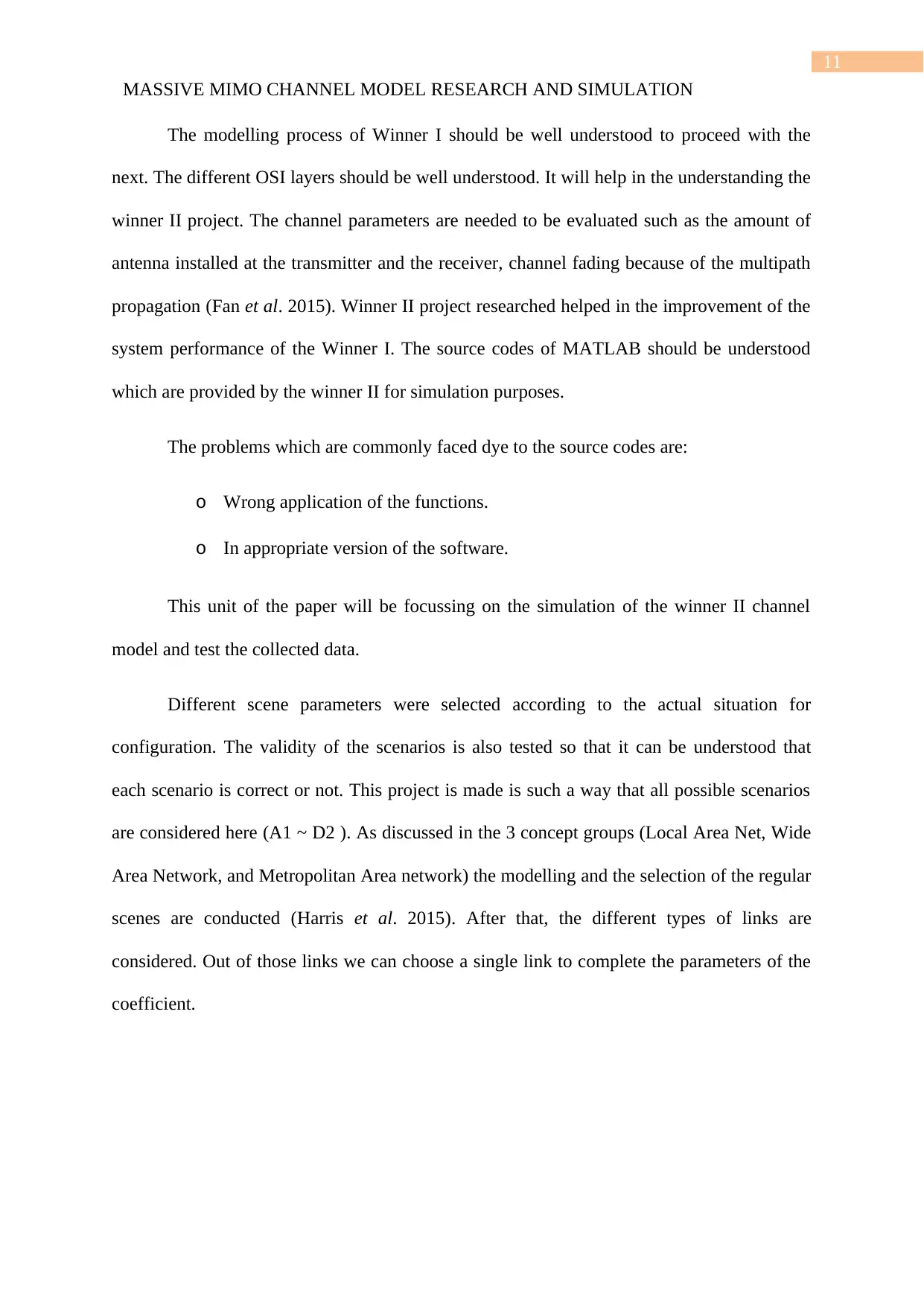
11
MASSIVE MIMO CHANNEL MODEL RESEARCH AND SIMULATION
The modelling process of Winner I should be well understood to proceed with the
next. The different OSI layers should be well understood. It will help in the understanding the
winner II project. The channel parameters are needed to be evaluated such as the amount of
antenna installed at the transmitter and the receiver, channel fading because of the multipath
propagation (Fan et al. 2015). Winner II project researched helped in the improvement of the
system performance of the Winner I. The source codes of MATLAB should be understood
which are provided by the winner II for simulation purposes.
The problems which are commonly faced dye to the source codes are:
o Wrong application of the functions.
o In appropriate version of the software.
This unit of the paper will be focussing on the simulation of the winner II channel
model and test the collected data.
Different scene parameters were selected according to the actual situation for
configuration. The validity of the scenarios is also tested so that it can be understood that
each scenario is correct or not. This project is made is such a way that all possible scenarios
are considered here (A1 ~ D2 ). As discussed in the 3 concept groups (Local Area Net, Wide
Area Network, and Metropolitan Area network) the modelling and the selection of the regular
scenes are conducted (Harris et al. 2015). After that, the different types of links are
considered. Out of those links we can choose a single link to complete the parameters of the
coefficient.
MASSIVE MIMO CHANNEL MODEL RESEARCH AND SIMULATION
The modelling process of Winner I should be well understood to proceed with the
next. The different OSI layers should be well understood. It will help in the understanding the
winner II project. The channel parameters are needed to be evaluated such as the amount of
antenna installed at the transmitter and the receiver, channel fading because of the multipath
propagation (Fan et al. 2015). Winner II project researched helped in the improvement of the
system performance of the Winner I. The source codes of MATLAB should be understood
which are provided by the winner II for simulation purposes.
The problems which are commonly faced dye to the source codes are:
o Wrong application of the functions.
o In appropriate version of the software.
This unit of the paper will be focussing on the simulation of the winner II channel
model and test the collected data.
Different scene parameters were selected according to the actual situation for
configuration. The validity of the scenarios is also tested so that it can be understood that
each scenario is correct or not. This project is made is such a way that all possible scenarios
are considered here (A1 ~ D2 ). As discussed in the 3 concept groups (Local Area Net, Wide
Area Network, and Metropolitan Area network) the modelling and the selection of the regular
scenes are conducted (Harris et al. 2015). After that, the different types of links are
considered. Out of those links we can choose a single link to complete the parameters of the
coefficient.
⊘ This is a preview!⊘
Do you want full access?
Subscribe today to unlock all pages.

Trusted by 1+ million students worldwide
1 out of 18
Your All-in-One AI-Powered Toolkit for Academic Success.
+13062052269
info@desklib.com
Available 24*7 on WhatsApp / Email
![[object Object]](/_next/static/media/star-bottom.7253800d.svg)
Unlock your academic potential
Copyright © 2020–2025 A2Z Services. All Rights Reserved. Developed and managed by ZUCOL.

